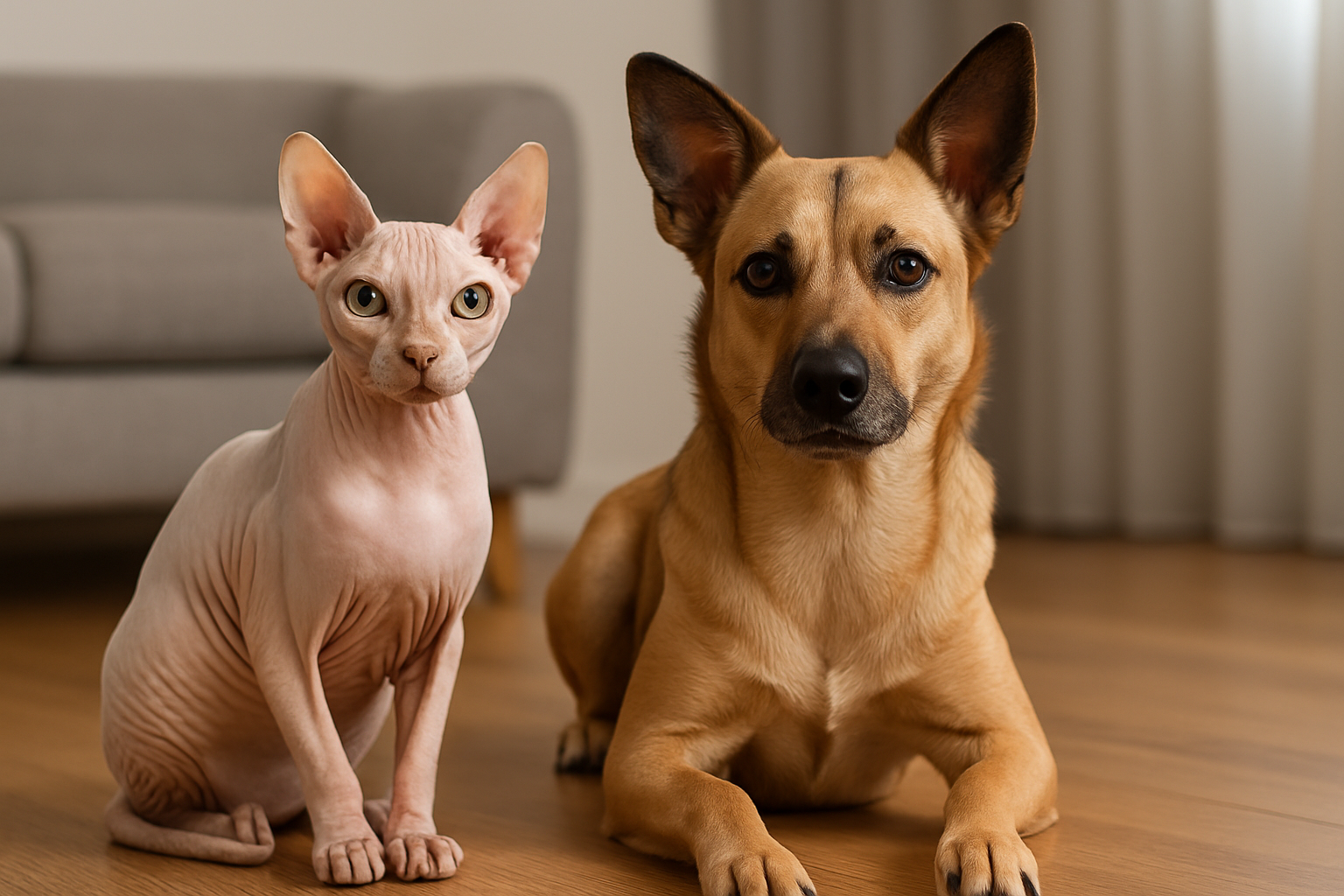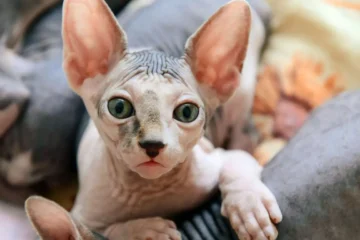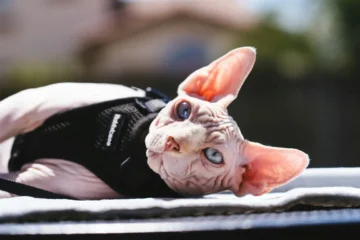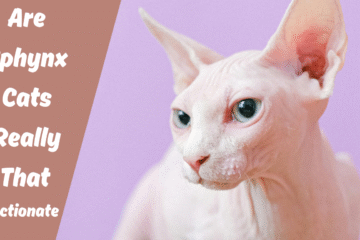Thinking about getting a Sphynx cat but worried about how they’ll get along with your dog? Here’s the real scoop from actual pet owners who’ve been there.
The Bottom Line: Yes, Sphynx Cats Usually Love Dogs
If you’re wondering whether your Sphynx cat and dog can be best friends, I have good news for you. Most Sphynx cats actually do great with dogs – sometimes even better than with other cats!
Here’s why: Sphynx cats are basically the golden retrievers of the cat world. They’re social, friendly, and love being around their family (including furry family members). Unlike those aloof cats you see in movies, Sphynx cats crave attention and companionship.
Why Sphynx Cats Are Perfect Dog Companions
They’re Social Butterflies
Sphynx cats don’t do the whole “I’m too cool for you” thing that other cats sometimes pull. They want to be where the action is, and if that means hanging out with the family dog, they’re totally up for it.
My neighbor Sarah has a Sphynx named Luna who follows her Golden Retriever Max everywhere. “Luna thinks she’s a dog,” Sarah laughs. “She even tries to fetch balls with Max.”
They Match Your Dog’s Energy
Got an active dog? Perfect. Sphynx cats are energetic and playful. They won’t just tolerate your dog’s playfulness – they’ll join right in. I’ve seen Sphynx cats play chase with dogs, wrestle (gently), and even share toys.
They’re Heat-Seeking Missiles
Here’s something cute: because Sphynx cats don’t have fur, they’re always looking for warm spots. And guess what makes a great heating pad? Your fluffy dog! Many owners tell me their Sphynx cat curls up with their dog for naps.
Real Stories from Sphynx Cat Owners
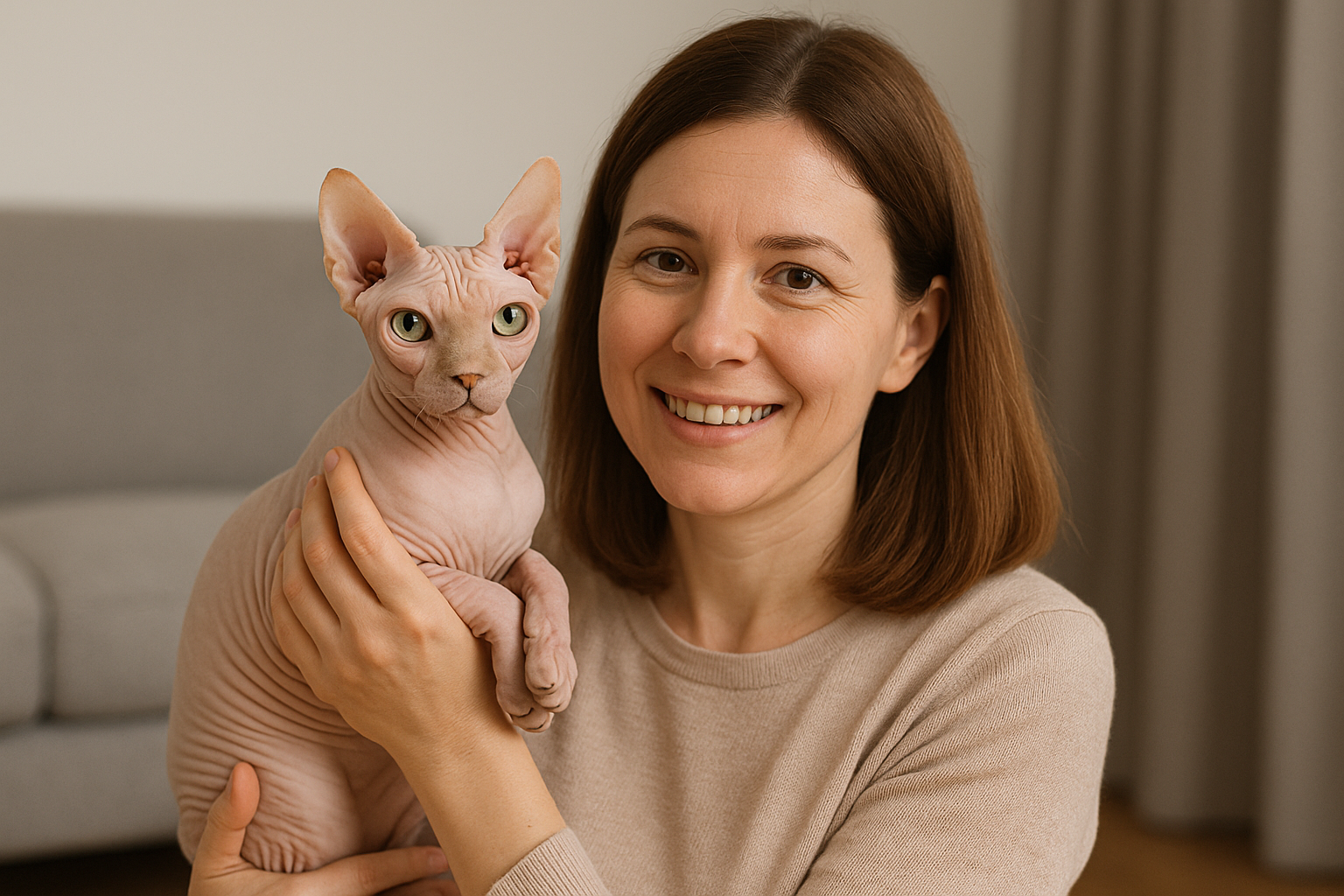
“My Cat Thinks She’s a Dog”
Jessica from Portland says her Sphynx cat Cleopatra has completely adopted her Labrador’s habits. “Cleo waits by the door when I get the leash out, follows Rex to his food bowl, and even tries to drink from his water dish. The vet says it’s totally normal – Sphynx cats are just social like that.”
“They’re Like an Old Married Couple”
Tom’s got a rescue Sphynx named Gizmo and a pit bull mix called Bruno. “At first, I was worried Bruno might be too rough, but Gizmo basically trained him to be gentle. Now they sleep together every night, and Bruno gets upset if Gizmo isn’t around.”
“My Dog Became a Cat Protector”
Maria noticed something sweet: her German Shepherd started “protecting” their new Sphynx kitten. “Kaiser would position himself between the kitten and strangers, and he’d gently guide the kitten away from anything dangerous. It was like watching a big brother in action.”
How to Introduce Your Sphynx Cat to Your Dog (The Right Way)
Week 1: Keep Them Apart (But Close)
Don’t just throw them together and hope for the best. Start by keeping them in separate rooms where they can smell each other under the door. This isn’t being mean – it’s letting them get curious about each other safely.
What to do:
- Set up separate spaces with food, water, and litter boxes
- Switch their bedding so they get used to each other’s scent
- Let them hear each other through the door
The ASPCA recommends this gradual scent introduction method as the safest way to introduce cats and dogs.”
Week 2: Let Them See Each Other
Now it’s time for the “wow, you’re real” moment. Use a baby gate or pet gate so they can see each other without being able to reach.
Watch for good signs:
- Relaxed body language
- Curiosity without aggression
- Play behavior (like pawing at each other through the gate)
Red flags to watch for:
- Hissing or growling
- Puffed up fur (on cats)
- Stiff, aggressive postures
Week 3: Supervised Hangouts
If they’re doing well with the gate, try short supervised visits in the same room. Keep your dog on a leash at first, and always have escape routes for your cat.
Pro tip: Feed them treats during these sessions. They’ll start associating each other with good things happening.
Week 4 and Beyond: Building the Friendship
By now, you should see some real bonding happening. Some cats and dogs click immediately, while others take months to become friends. Both are normal!
What Makes This Work (And What Doesn’t)
Your Dog’s Personality Matters
Dogs that usually do great with Sphynx cats:
- Calm, gentle breeds like Golden Retrievers
- Dogs that are already socialized with cats
- Puppies (they grow up together)
- Dogs with similar energy levels
Dogs that might need extra work:
- High-prey drive breeds (like some terriers)
- Dogs with no cat experience
- Very large dogs that might accidentally hurt a cat
- Dogs with resource guarding issues
Your Cat’s Background Counts Too
Sphynx cats that adapt faster:
- Kittens (they’re more flexible)
- Cats from breeders who socialize with dogs
- Social, confident cats
- Cats that have lived with other pets before
Cats that might need more time:
- Rescue cats with unknown histories
- Cats that have been only-pets their whole lives
- Shy or anxious cats
- Older cats set in their ways
Common Problems (And How to Fix Them)
Problem: Your Dog is Too Excited
What it looks like: Your dog wants to play, but they’re too rough or energetic for your cat.
The fix: Work on basic training commands like “gentle” and “leave it.” Practice with toys first, then use the same commands around your cat. Reward calm behavior around the cat with treats.
Problem: Your Cat is Scared
What it looks like: Your Sphynx cat hides, won’t eat, or seems stressed.
The fix: Slow down the introduction process. Give your cat more time to adjust, and make sure they have high places to retreat to. Consider using calming pheromones designed for cats.
Problem: Resource Guarding
What it looks like: Fighting over food, toys, or your attention.
The fix: Feed them in separate areas, provide multiple toys, and give both pets individual attention. Don’t force them to share everything.
Problem: Temperature Issues
What it looks like: Your Sphynx cat is always cold and competing with your dog for warm spots.
The fix: Get heated cat beds, ensure your home is warm enough, and consider cat-safe heating pads. Sometimes the solution is as simple as getting a bigger dog bed they can share!
Making It Work Long-Term
Give Each Pet What They Need
For your Sphynx cat:
- Warm sleeping spots (they get cold easily)
- High perches to observe from
- Interactive toys for mental stimulation
- Regular baths and skin care
For your dog:
- Regular exercise and walks
- Their own toys and space
- Continued training and socialization
- Consistent routines
Create Positive Experiences Together
Meal time: Feed them in the same room (but not from the same bowl). This creates positive associations.
Play time: Supervise play sessions and reward good behavior from both pets.
Cuddle time: If they’re comfortable, let them join you on the couch together. Many owners find this helps bond the pets.
Training: Practice basic commands with both pets present. This reinforces the family pack mentality.
Red Flags: When to Get Help
Call a Professional If:
- There’s any real aggression (not just posturing)
- Either pet stops eating or drinking
- Your cat starts having litter box problems
- Your dog becomes destructive or anxious
- After a month, there’s no improvement
Your Vet Can Help With:
- Ruling out health issues causing behavioral problems
- Recommending anti-anxiety medications if needed
- Connecting you with certified animal behaviorists
- Providing species-specific advice
Special Things to Know About Sphynx Cats
They’re Not Like Other Cats
Temperature sensitive: Your Sphynx cat will seek out warm spots, which might mean cuddling with your dog more than other cats would.
Super social: They don’t want to be alone. Having a dog companion can actually be great for their mental health.
Attention seekers: They want to be involved in everything, which can sometimes create competition with your dog for your attention.
Vocal: Sphynx cats “talk” more than other cats. Your dog might need time to get used to all the chattering.
Health and Safety Tips
Protect that skin: Make sure your dog’s nails are trimmed to avoid accidental scratches during play.
Watch the temperature: In summer, make sure your Sphynx doesn’t overheat while cuddling with your warm, furry dog.
Monitor stress: Sphynx cats can develop skin issues when stressed, so watch for any changes during the introduction period.
The Reality Check: What to Expect
Month 1: The Adjustment Period
Expect some awkwardness. Your pets are figuring each other out. Some days will be great, others might have setbacks. This is totally normal.
Month 2-3: Finding Their Rhythm
You’ll start seeing their personalities emerge in the relationship. Maybe your cat becomes the bossy one, or your dog becomes protective. Let them work out their dynamic.
Month 6+: The Real Friendship
By now, you should see their true relationship. Some will be inseparable best friends, others will be polite roommates. Both are perfectly fine!
Success Stories That’ll Make You Smile
The Warmth Sharers
“My Sphynx cat Radar and my Husky Snowball have this routine where Snowball lies down first, then Radar comes and curls up right against his belly. Snowball never moves until Radar wakes up. It’s the sweetest thing.” – Michelle, Denver
The Play Partners
“I got my Sphynx kitten Yoda when my Border Collie Finn was about two. Now they chase each other around the house, and Yoda has learned to play fetch! My friends can’t believe it when they see my cat bringing back toy mice.” – David, Austin
The Protectors
“When strangers come over, my Sphynx cat Nala and my rescue pit bull Diesel both position themselves between the visitor and me. It’s like they’re a team protecting the house. Nala will even meow to ‘tell’ Diesel about things she thinks are suspicious.” – Carmen, Miami
Why This Combination Actually Works So Well
They Fill Each Other’s Needs
Your dog gets: A playmate who’s always around, someone to keep them company when you’re gone, and a buddy who matches their social energy.
Your cat gets: Warmth, companionship, and someone who can keep up with their active lifestyle.
You get: Two pets who entertain each other, which can mean less destructive behavior and more adorable moments.
They’re Both People-Oriented
Unlike some cat breeds that are more independent, Sphynx cats are people-focused. So are most dogs. This means they’re both competing for your attention, but they’re also both motivated to please you – which includes getting along with each other.
The Bottom Line: It’s Usually Worth It
Most Sphynx cat and dog combinations work out great. Yes, it takes some patience during the introduction period, and every pet is different. But the success stories far outnumber the failures.
If you’re thinking about adding a Sphynx cat to your dog-loving household, go for it – just do it right. Take your time with introductions, be patient with the process, and don’t expect instant best friends (though it does happen sometimes).
The reward? You might just end up with the most entertaining pet duo you’ve ever seen. And trust me, watching a hairless cat and a fluffy dog become best friends is pretty much guaranteed to make your day, every day.
One last tip: Take lots of photos and videos during the process. These relationships often turn into the most heartwarming content you’ll ever capture, and you’ll want to remember every step of their friendship journey.
Got a Sphynx cat and dog success story? I’d love to hear about it! Share your experience in the comments – other pet parents would love to know how you made it work.

